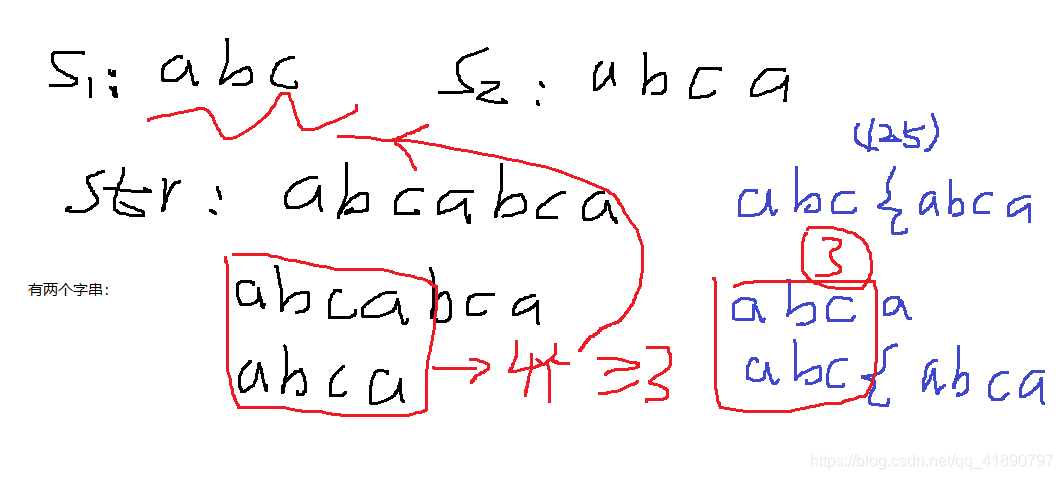The little cat is majoring in physics in the capital of Byterland. A piece of sad news comes to him these days: his mother is getting ill. Being worried about spending so much on railway tickets (Byterland is such a big country, and he has to spend 16 shours on train to his hometown), he decided only to send SMS with his mother.
The little cat lives in an unrich family, so he frequently comes to the mobile service center, to check how much money he has spent on SMS. Yesterday, the computer of service center was broken, and printed two very long messages. The brilliant little cat soon found out:
1. All characters in messages are lowercase Latin letters, without punctuations and spaces.
2. All SMS has been appended to each other – (i+1)-th SMS comes directly after the i-th one – that is why those two messages are quite long.
3. His own SMS has been appended together, but possibly a great many redundancy characters appear leftwards and rightwards due to the broken computer.
E.g: if his SMS is “motheriloveyou”, either long message printed by that machine, would possibly be one of “hahamotheriloveyou”, “motheriloveyoureally”, “motheriloveyouornot”, “bbbmotheriloveyouaaa”, etc.
4. For these broken issues, the little cat has printed his original text twice (so there appears two very long messages). Even though the original text remains the same in two printed messages, the redundancy characters on both sides would be possibly different.
You are given those two very long messages, and you have to output the length of the longest possible original text written by the little cat.
Background:
The SMS in Byterland mobile service are charging in dollars-per-byte. That is why the little cat is worrying about how long could the longest original text be.
Why ask you to write a program? There are four resions:
1. The little cat is so busy these days with physics lessons;
2. The little cat wants to keep what he said to his mother seceret;
3. POJ is such a great Online Judge;
4. The little cat wants to earn some money from POJ, and try to persuade his mother to see the doctor :(
Input
Two strings with lowercase letters on two of the input lines individually. Number of characters in each one will never exceed 100000.
Output
A single line with a single integer number – what is the maximum length of the original text written by the little cat.
Sample Input
yeshowmuchiloveyoumydearmotherreallyicannotbelieveit yeaphowmuchiloveyoumydearmother
Sample Output
27
题意:求两个字符串的最长公共连续字符串的长度。
思路: 因为是求连续的公共子字符串,那么我们可以将两个字符串拼接成一个字符串,通过后缀字串的性质(任何后缀字串的前缀都是原字符串的字串)我们就可以找到最长的重复字串了。确保找到的两个字串一个是第一个字符串的字串,另一个数第二个字符串的字串。
技巧:后缀数组模板Orz... 特殊处理:我们在拼接字符串的时候,可以在第一个字符串拼接完成后再加一个最大字符(127),为的只是在排序后,更方便求最长公共子字符串,作用如下:

代码如下:
/*
求两个字符串的最长连续公共子字符串
思路:将两个字符串拼接(len=l1+l2),然后求后缀数组。每个后缀数组的前缀便是一个子串。
因此我们可以在(0->l1) (l1->len)的范围内找出最长公共字串
*/
#include<cstdio>
#include<cstring>
#include<algorithm>
#define N 200010
#define inf 0x3f3f3f3f
using namespace std;
char str[N],s[N],t[N];
int wa[N],wb[N],wv[N],ws[N];
int cmp(int *r,int a,int b,int l)
{
return r[a]==r[b]&&r[a+l]==r[b+l];
}
void da(const char r[],int sa[],int n,int m)
{
int i,j,p,k;
int *x=wa,*y=wb,*t;
for(i=0; i<m; i++)ws[i]=0;
for(i=0; i<n; i++)ws[x[i]=r[i]]++;
for(i=1; i<m; i++)ws[i]+=ws[i-1];
for(i=n-1; i>=0; i--)sa[--ws[x[i]]]=i;
for(j=1,p=1; p<n; j*=2,m=p)
{
for(p=0,i=n-j; i<n; i++)y[p++]=i;
for(i=0; i<n; i++)if(sa[i]>=j)y[p++]=sa[i]-j;
for(i=0; i<n; i++)wv[i]=x[y[i]];
for(i=0; i<m; i++)ws[i]=0;
for(i=0; i<n; i++)ws[wv[i]]++;
for(i=1; i<m; i++)ws[i]+=ws[i-1];
for(i=n-1; i>=0; i--)sa[--ws[wv[i]]]=y[i];
t=x;x=y;y=t;
for(p=1,x[sa[0]]=0,i=1; i<n; i++)
x[sa[i]]=cmp(y,sa[i-1],sa[i],j)?p-1:p++;
}
return;
}
int sa[N],Rank[N],height[N];
void calheight(const char r[],int sa[],int n)
{
int i,j,k=0;
for(i=1; i<=n; i++) Rank[sa[i]]=i;
for(i=0; i<n; height[Rank[i++]]=k)
for(k?k--:0,j=sa[Rank[i]-1]; r[i+k]==r[j+k]; k++);
for(i=n; i>=1; --i) ++sa[i],Rank[i]=Rank[i-1];
}
int main()
{
int n;
while(~scanf("%s%s",s,t))
{
int l1=strlen(s);
int l2=strlen(t);
int len=0;
for(int i=0; i<l1; i++)
str[len++]=s[i];
str[len++]=125; //在第一个字符串后面加一个最大的值,成为两个字符串的分界点。优化了后序的排序
for(int i=0; i<l2; i++)
str[len++]=t[i];
str[len]=0;
da(str,sa,len+1,130);
calheight(str,sa,len);
/* //后缀数组模板,方便观察各种值
puts("--------------All Suffix--------------");
for(int i=1; i<=len; ++i)
{
printf("%d:\t",i);
for(int j=i-1; j<len; ++j)
printf("%c",str[j]);
puts("");
}
puts("");
puts("-------------After sort---------------");
for(int i=1; i<=len; ++i)
{
printf("sa[%2d ] = %2d\t",i,sa[i]);
for(int j=sa[i]-1; j<len; ++j)
printf("%c",str[j]);
puts("");
}
puts("");
puts("---------------Height-----------------");
for(int i=1; i<=len; ++i)
printf("height[%2d ]=%2d \n",i,height[i]);
puts("");
puts("----------------Rank------------------");
for(int i=1; i<=len; ++i)
printf("Rank[%2d ] = %2d\n",i,Rank[i]);
puts("------------------END-----------------");
*/
int maxl=0;
for(int i=2; i<len; i++)
{
if(height[i]>maxl)
{
int a=sa[i-1];
int b=sa[i];
if(a>0&&a<=l1&&b>l1)
{
if(height[i]>maxl)maxl=height[i];
}
else if(b>0&&b<=l1&&a>l1)
{
if(height[i]>maxl)maxl=height[i];
}
}
}
printf("%d\n",maxl);
}
}





 本文介绍了一种求两个字符串最长公共连续子字符串的算法,通过拼接字符串并利用后缀数组的特性来寻找最长重复子串。文章详细解释了算法的背景、思路和特殊处理方法,并提供了完整的代码实现。
本文介绍了一种求两个字符串最长公共连续子字符串的算法,通过拼接字符串并利用后缀数组的特性来寻找最长重复子串。文章详细解释了算法的背景、思路和特殊处理方法,并提供了完整的代码实现。
















 1万+
1万+

 被折叠的 条评论
为什么被折叠?
被折叠的 条评论
为什么被折叠?








